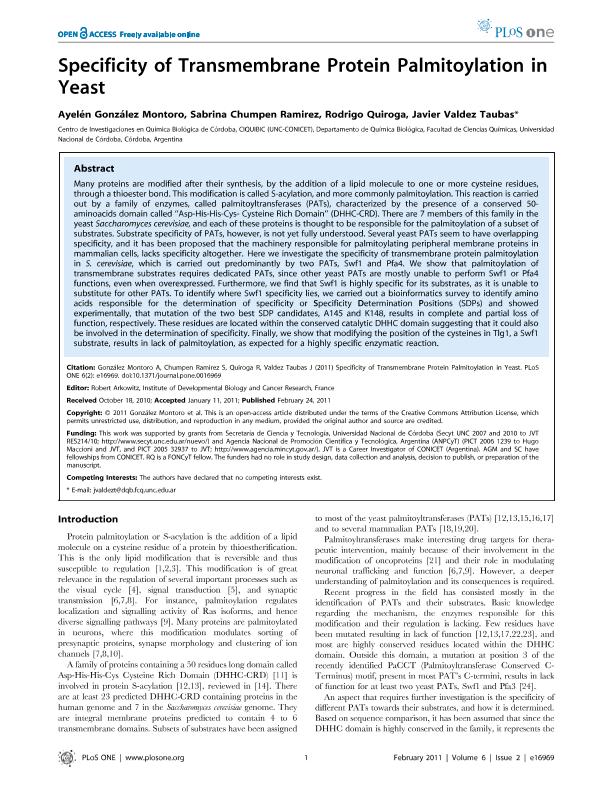Artículo
Specificity of transmembrane protein palmitoylation in yeast
González Montoro, María Ayelén ; Chumpen Ramirez, Sabrina Vanesa
; Chumpen Ramirez, Sabrina Vanesa ; Quiroga, Rodrigo
; Quiroga, Rodrigo ; Valdez, Javier Esteban
; Valdez, Javier Esteban
 ; Chumpen Ramirez, Sabrina Vanesa
; Chumpen Ramirez, Sabrina Vanesa ; Quiroga, Rodrigo
; Quiroga, Rodrigo ; Valdez, Javier Esteban
; Valdez, Javier Esteban
Fecha de publicación:
02/2011
Editorial:
Public Library of Science
Revista:
Plos One
ISSN:
1932-6203
Idioma:
Inglés
Tipo de recurso:
Artículo publicado
Clasificación temática:
Resumen
Many proteins are modified after their synthesis, by the addition of a lipid molecule to one or more cysteine residues, through a thioester bond. This modification is called S-acylation, and more commonly palmitoylation. This reaction is carried out by a family of enzymes, called palmitoyltransferases (PATs), characterized by the presence of a conserved 50- aminoacids domain called ‘‘Asp-His-His-Cys- Cysteine Rich Domain’’ (DHHC-CRD). There are 7 members of this family in the yeast Saccharomyces cerevisiae, and each of these proteins is thought to be responsible for the palmitoylation of a subset of substrates. Substrate specificity of PATs, however, is not yet fully understood. Several yeast PATs seem to have overlapping specificity, and it has been proposed that the machinery responsible for palmitoylating peripheral membrane proteins in mammalian cells, lacks specificity altogether. Here we investigate the specificity of transmembrane protein palmitoylation in S. cerevisiae, which is carried out predominantly by two PATs, Swf1 and Pfa4. We show that palmitoylation of transmembrane substrates requires dedicated PATs, since other yeast PATs are mostly unable to perform Swf1 or Pfa4 functions, even when overexpressed. Furthermore, we find that Swf1 is highly specific for its substrates, as it is unable to substitute for other PATs. To identify where Swf1 specificity lies, we carried out a bioinformatics survey to identify amino acids responsible for the determination of specificity or Specificity Determination Positions (SDPs) and showed experimentally, that mutation of the two best SDP candidates, A145 and K148, results in complete and partial loss of function, respectively. These residues are located within the conserved catalytic DHHC domain suggesting that it could also be involved in the determination of specificity. Finally, we show that modifying the position of the cysteines in Tlg1, a Swf1 substrate, results in lack of palmitoylation, as expected for a highly specific enzymatic reaction.
Palabras clave:
Palmitoylation
,
yeast
,
Transmembrane proteins
,
palmitoyltranferases
Archivos asociados
Licencia
Identificadores
Colecciones
Articulos(CIQUIBIC)
Articulos de CENTRO DE INVEST.EN QCA.BIOL.DE CORDOBA (P)
Articulos de CENTRO DE INVEST.EN QCA.BIOL.DE CORDOBA (P)
Citación
González Montoro, María Ayelén; Chumpen Ramirez, Sabrina Vanesa; Quiroga, Rodrigo; Valdez, Javier Esteban; Specificity of transmembrane protein palmitoylation in yeast; Public Library of Science; Plos One; 6; 2; 2-2011; 1-13
Compartir
Altmétricas



